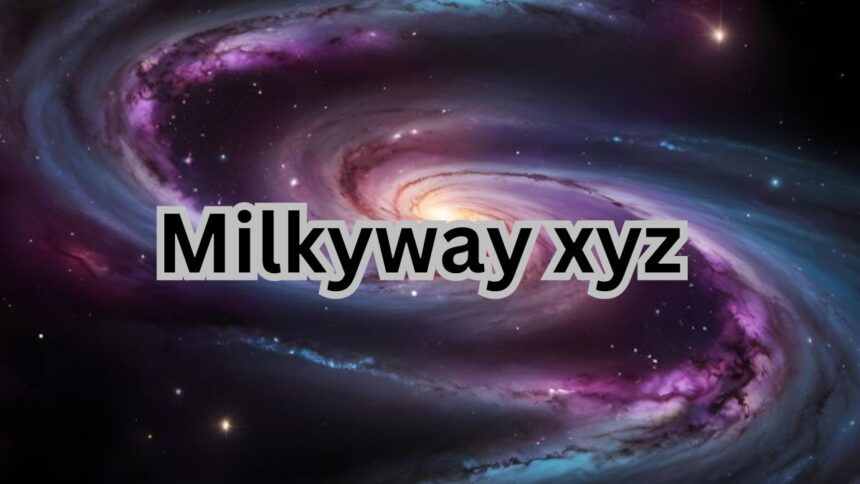The MilkyWay xyz , our home galaxy, is an awe-inspiring spectacle that has fascinated humanity for centuries. Spanning billions of stars and countless mysteries, the Milky Way is not just a distant swirl of light in the night sky but a cosmic structure that holds the key to understanding the universe. In this article, we’ll dive into the wonders of the Milky Way, exploring its structure, the stars within it, and what the future holds for this magnificent galaxy.
What is the Milky Way?
The Milkyway xyz is a barred spiral galaxy, home to our Solar System and countless other stars, planets, and cosmic phenomena. It is part of the Local Group of galaxies, which includes the Andromeda Galaxy and several others. The name “Milky Way” comes from the ancient Greeks, who described the appearance of the galaxy as a “milky” band of light stretching across the night sky.
The Structure of the Milky Way
The Milky Way is a complex structure, with a disk-shaped body that measures about 100,000 light-years in diameter. At its center lies a bulging core surrounded by spiral arms that extend outward, creating the galaxy’s distinctive shape. The disk contains most of the galaxy’s stars, dust, and gas, while the halo, a roughly spherical region surrounding the disk, contains older stars and globular clusters.
The Solar System’s Place in the Milkyway xyz
Our Solar System resides in one of the Milky Way’s spiral arms, specifically the Orion Arm, located about 27,000 light-years from the galactic center. This positioning provides us with a spectacular view of the galaxy, allowing astronomers to study the Milky Way’s structure and contents from within.
Formation of the Milky Way
The Milkyway xyz formation began around 13.6 billion years ago, shortly after the Big Bang. It started as a massive cloud of gas and dust that eventually collapsed under gravity, leading to the formation of the first stars and clusters. Over billions of years, these early stars and clusters merged and evolved, forming the galaxy we see today.
Stars Within the Milky Way
The Milky Way contains an estimated 100 to 400 billion stars, each with its own unique properties. These stars range from massive, hot blue giants to smaller, cooler red dwarfs. Some stars are part of binary systems, while others exist as solitary entities. The diversity of stars within the Milky Way reflects the complex processes that have shaped the galaxy over time.
Dark Matter and the Milky Way
Dark matter, an invisible and mysterious form of matter, plays a crucial role in the Milky Way’s structure. Although it cannot be seen directly, dark matter’s gravitational influence is essential in holding the galaxy together. Scientists believe that dark matter makes up about 27% of the universe’s mass, far outweighing the visible matter within galaxies like the Milky Way.
Galactic Center: The Heart of the Milky Way
At the heart of the Milky Way lies the galactic center, a region teeming with activity and dominated by a supermassive black hole known as Sagittarius A*. This black hole, with a mass equivalent to about 4 million suns, exerts a powerful gravitational force, influencing the movement of stars and gas within the galaxy’s core.
The Milky Way’s Spiral Arms
The Milky Way’s spiral arms are regions of high star density, where new stars are constantly being born. These arms are named after constellations they pass through, such as the Sagittarius Arm and the Perseus Arm. The spiral structure is maintained by density waves that propagate through the galaxy, compressing gas and dust and triggering star formation.
The Milky Way in the Night Sky
From Earth, the Milky Way appears as a faint band of light stretching across the night sky. This light comes from the combined glow of billions of stars within the galaxy’s disk. The best views of the Milky Way can be seen from dark, rural areas, far from city lights, where the galaxy’s splendor can be fully appreciated.
Milky Way and Other Galaxies
The Milky Way is not an isolated entity; it interacts with other galaxies, most notably the Andromeda Galaxy. These interactions can lead to galaxy mergers, where two galaxies combine to form a larger structure. In fact, scientists predict that the Milky Way and Andromeda will collide in about 4.5 billion years, eventually merging to form a new galaxy.
The Future of the Milky Way
The Milky Way is constantly evolving. Over time, it will continue to interact with other galaxies, possibly absorbing smaller galaxies in the process. The upcoming collision with the Andromeda Galaxy will significantly reshape the Milky Way, leading to the creation of a new galactic structure. However, this event is still billions of years away, giving us plenty of time to study and appreciate our galaxy.
Exploring the Milky Way: Past, Present, and Future
Throughout history, the Milky Way has been a source of wonder and inspiration. Ancient civilizations used the galaxy to navigate and mark the passage of time, while modern astronomers have uncovered its secrets using advanced technology. As we continue to explore the Milky Way, new discoveries will undoubtedly reshape our understanding of the galaxy and the universe as a whole.
Why the Milky Way Fascinates Us
The Milky Way captivates us because it represents the vastness and mystery of the universe. It is a reminder of our place in the cosmos and the infinite possibilities that lie beyond our planet. The beauty of the Milky Way, with its swirling arms and countless stars, evokes a sense of wonder and curiosity, driving us to explore and understand the universe.
Conclusion
The Milkyway xyz is a marvel of the universe, a galaxy that holds countless secrets and endless beauty. From its spiral arms to its supermassive black hole, the Milkyway xyz is a testament to the complexity and grandeur of the cosmos. As we continue to study and explore this galaxy, we uncover new mysteries that deepen our appreciation for the universe and our place within it.
FAQs
What is the Milky Way?
The Milky Way is a barred spiral galaxy that contains our Solar System, along with billions of other stars, planets, and cosmic phenomena.
How old is the Milky Way?
The Milky Way is approximately 13.6 billion years old, formed shortly after the Big Bang.
Where is the Solar System located in the Milky Way?
The Solar System is located in the Orion Arm of the Milky Way, about 27,000 light-years from the galactic center.
What is at the center of the Milky Way?
At the center of the Milky Way lies a supermassive black hole known as Sagittarius A*, which has a mass equivalent to about 4 million suns.
Will the Milky Way ever collide with another galaxy?
Yes, scientists predict that the Milky Way will collide with the Andromeda Galaxy in about 4.5 billion years, eventually merging to form a new galaxy.







